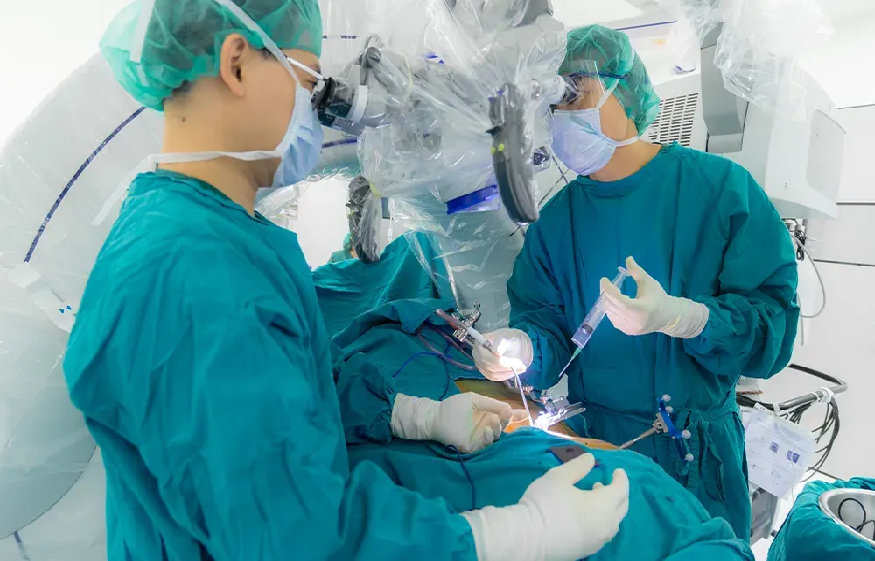Artificial intelligence (AI) is revolutionizing spinal surgery by improving preoperative planning and enabling highly personalized and precise treatment strategies. For disc replacement procedures, AI provides invaluable insights by analyzing complex data, enhancing outcome predictions and tailoring surgical plans to each patient’s unique spinal structure and needs. Dr. Larry Davidson, an experienced spine specialist and advocate for advanced technologies in spinal care, recognizes the role of AI in preoperative planning for disc replacement, including its applications in imaging, predictive modeling and surgical navigation.
AI’s Role in Advanced Imaging and Patient Assessment
AI is enhancing preoperative imaging by interpreting complex images with greater potential for accuracy and efficiency than traditional methods. High-resolution MRI and CT scans generate detailed views of the spine, which AI algorithms can analyze to assess disc health, spinal alignment and potential complications.
Detailed 3D Modeling of the Spine: AI-powered software uses imaging data to create 3D models of each patient’s spine, providing surgeons with a comprehensive view of the affected area. These models can highlight subtle structural variations that could affect the positioning of the artificial disc, allowing for precise pre-surgical planning.
Automatic Identification of Disc Damage and Degeneration: AI algorithms are trained to detect degenerative disc disease and herniation accurately. They assess the extent of damage to determine whether disc replacement is the most appropriate treatment. This assessment is faster and more objective than manual evaluations, giving surgeons a more reliable basis for their treatment decisions.
Predicting Surgical Suitability and Risks: AI can analyze patient-specific factors like bone density, alignment and comorbidities to assess suitability for disc replacement surgery. By identifying risk factors early, AI can assist in tailoring the surgical approach, such as by suggesting adjustments in disc positioning or exploring alternative treatments, contributing to a more personalized and risk-aware plan.
Creating Personalized Treatment Plans Through AI-Driven Predictive Modeling
AI-driven predictive modeling is a key tool for generating personalized treatment plans in spinal surgery. By analyzing historical data and patient-specific information, AI may forecast potential outcomes, recovery timelines and possible complications, helping surgeons make more data-informed decisions.
Outcome Prediction for Enhanced Decision-Making: Predictive models draw from large datasets of past surgeries, helping to predict the potential outcomes for disc replacement patients based on similar cases. For example, AI can estimate how much motion a patient will retain after surgery or the likelihood of adjacent segment disease (ASD) developing. This information may help both surgeons and patients make more informed decisions about the procedure.
Simulating Different Surgical Scenarios: AI enables virtual simulations where surgeons can test different disc placements and implant types on a patient-specific model. By exploring various scenarios, AI helps identify the optimal approach for everyone, reducing the chances of complications and increasing the likelihood of achieving the desired outcome.
Tailoring Implants to Individual Anatomy: AI can recommend the best type and size of artificial disc based on a patient’s spinal structure. For instance, a patient with a narrower spinal canal or atypical vertebrae might need a customized implant or specific positioning to avoid nerve impingement. This level of customization enhances both the accuracy of the procedure and the longevity of the implant.
Enhancing Surgical Precision with AI-Guided Navigation Systems
During spinal surgery, even the smallest deviation in disc placement can affect patient outcomes. AI-powered navigation systems provide real-time guidance to surgeons, helping them achieve precise positioning and alignment based on the preoperative plan.
Real-Time Tracking and Alignment: AI-guided navigation systems use sensors and imaging to track surgical instruments and patient positioning in real-time. This live feedback allows surgeons to adjust their movements precisely, ensuring that the artificial disc is placed according to the preoperative plan down to the millimeter.
Augmented Reality (AR) and AI for Enhanced Visualization: Some AI systems integrate with augmented reality (AR) to overlay a virtual image of the patient’s anatomy onto the surgical field, providing enhanced visualization of critical areas like nerves and blood vessels. This fusion of AI and AR can help to reduce the risk of errors and may enable more intuitive, controlled movements for the surgeon.
Minimizing Invasive Techniques: By providing clear, AI-driven guidance, surgeons can adopt minimally invasive techniques that involve smaller incisions and reduced tissue disruption. AI-guided precision minimizes the need for exploratory actions, which in turn leads to quicker recovery times, less postoperative pain and lower infection risk for patients undergoing disc replacement.
Benefits of AI-Driven Preoperative Planning for Patient Outcomes
AI’s ability to personalize and optimize preoperative planning translates directly into better outcomes and patient satisfaction. Patients benefit from shorter recovery times, fewer complications and improved overall surgical precision.
Reduced Risk of Complications: AI’s predictive analytics and personalized planning can help to reduce the likelihood of complications by accounting for factors like spinal misalignment, implant wear risks and surgical approach. Patients with complex spinal issues benefit significantly from this tailored approach, as the preoperative plan mitigates potential risks before surgery even begins.
Enhanced Motion Preservation and Comfort: By tailoring disc placement to each patient’s anatomy and movement patterns, AI helps optimize motion preservation, leading to a more natural range of motion post-surgery. This contributes to greater comfort, reduced postoperative stiffness and a more satisfying outcome for the patient.
Higher Long-Term Success Rates: AI-assisted planning may contribute to better alignment and positioning of the artificial disc, which could potentially extend the implant’s longevity and help reduce the need for revision surgeries. Patients experience sustained pain relief, improved functionality and higher satisfaction with the procedure’s outcomes.
Challenges and Future Directions for AI in Spinal Surgery
While AI offers numerous benefits, challenges remain in terms of technology integration, data privacy and cost. Ensuring that AI algorithms are robust, unbiased and validated across diverse populations is essential for continued success. Additionally, surgeons need training and familiarity with AI-based systems to maximize their benefits and incorporate them seamlessly into practice.
Looking forward, advancements in machine learning and AI-powered robotics hold promise for even greater precision and personalization in spinal surgery. Future AI applications may further enhance preoperative planning, offering real-time adjustments based on patient feedback and more interactive, patient-specific simulations. These innovations could make spinal disc replacement an even safer, more effective procedure, pushing the boundaries of personalized spine care.
AI is helping to shape preoperative planning in spinal disc replacement by providing surgeons with personalized, data-driven insights that may enhance surgical precision and patient outcomes. Dr. Larry Davidson observes that through advanced imaging, predictive modeling and AI-guided navigation, each aspect of pre-surgical planning becomes more tailored to the patient’s unique anatomy and needs. As AI technology continues to evolve, its role in spinal surgery is likely to expand, promising an era of highly personalized, minimally invasive treatments that deliver optimal results for patients with disc-related spinal issues.



